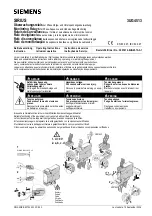
10
TB MRF3 04.01 E
4.4
Measurement of the frequency gra-
dient (rate of change of frequency)
Supervision of the frequency gradient df/dt is applied
to the following applications:
•
As additional criteria for underfrequency supervi-
sion at load shedding systems
•
For fast decoupling of mains parallel electrical
generators at mains failure (mains decoupling)
•
With frequency limiting function top and/or bottom
(setting-up of a trip window)
The df/dt elements can be set accordingly depending
on the type of application .
4.4.1
Load shedding
In the event of large interferences in the power genera-
tion grid, the failure of several power generators may
endanger the stability of the entire grid. The created
power deficit causes the mains frequency to drop rap-
idly.
The
MRF3
can be used for defined load shedding in
order to re-stabilise the grid.
For this purpose, the parameters of the four frequency
stages are set for immediate load shedding.
After grid stabilisation the shed load can be connected
again after a reclaim time.
fx
tfx>
fx+R
Rückfallwert
Reclaim value
Anregung
pickup
Rückschaltzeit
Reclaim Time
Auslösezeit
Tripping Time
Relais
Relay
tR
tfx>+tR
Figure 4.2: Reclaim time after mains recovery
In addition, the
MRF3
offers two measuring stages for
the frequency gradient df/dt. The amount of power
deficit can be determined by way of the frequency
change speed and this way appropriate load shed-
ding can be initiated.
The conventional method of supervising the frequency
gradient by using "load shedding" shows the following
disadvantages in practical application:
•
At the beginning of a mains failure the frequency
gradient may differ greatly from one substation to
the next and is, from a time point of view, not con-
stant in most cases. This depends on the power re-
quired by the individual substations. This makes se-
lective shut-down of consumers more difficult.
•
During a frequency decrease in the grid the power
between the individual power stations may fluctu-
ate. In this situation the frequency gradient is not
constant which makes a safe decision for tripping
on the basis of the momentary value of the fre-
quency gradient impossible.
On account of the above-mentioned disadvantages
only the consideration of the average value of the fre-
quency gradient makes sense for a df/dt supervision
with load shedding systems.
Since the frequency gradient supervision of the
MRF3
can work on this principle, the above-mentioned prob-
lems can be excluded.
Remark:
The jumper J3, which is located behind the display
panel, must not be plugged in (automatic reset of the
relays).
The function of the jumper J3 is that all energised re-
lays go into self-holding position and are only de-
energised by manual resetting. This would prevent re-
setting of the trip relay.
Summary of Contents for MRF3
Page 1: ...MRF3 Frequency Relay...











































